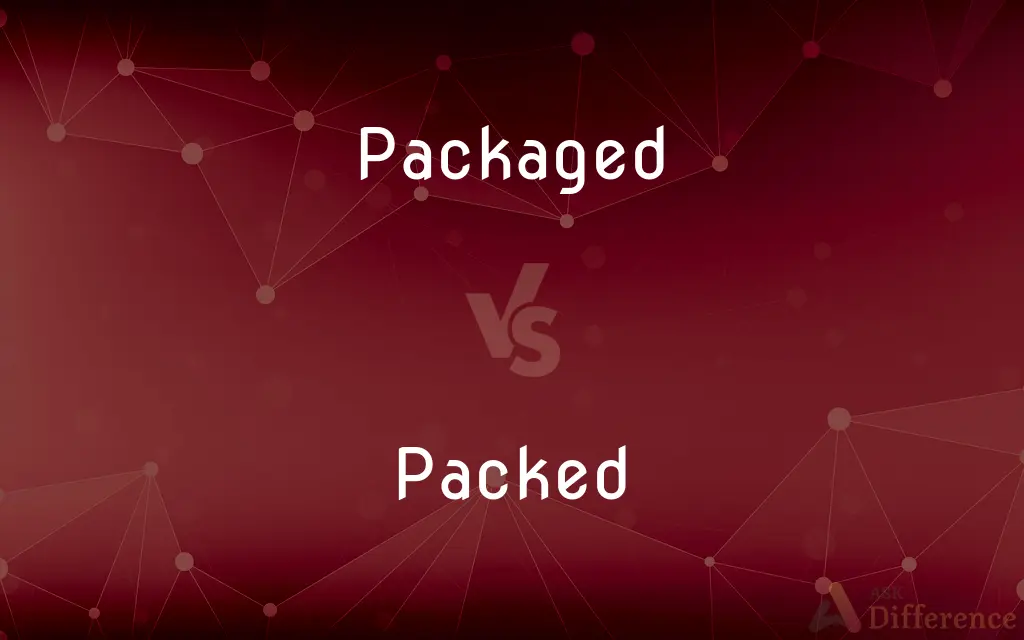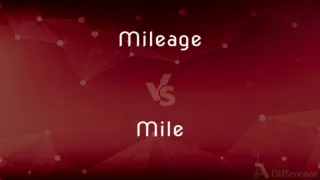Packaged vs. Packed — What's the Difference?
By Urooj Arif & Fiza Rafique — Updated on April 16, 2024
Packaged goods are prepared for retail in secure containers or wrappings; packed refers to items densely filled or stored, often for personal transport.

Difference Between Packaged and Packed
Table of Contents
ADVERTISEMENT
Key Differences
Packaged goods typically include commercial products prepared in secure, often branded, containers designed for sale. Whereas, "packed" generally refers to how items are densely filled into a space or container, such as a suitcase or a box.
Packaging often involves materials that protect and preserve the contents, such as plastic, cardboard, or foil, ideal for shelf stability and consumer appeal. On the other hand, packed items might simply be placed tightly together without consideration for long-term preservation or presentation.
Packaged products are usually associated with instructions, ingredients, and branding, providing consumers with necessary product information. Packed items, however, are primarily focused on maximizing space and may not include such detailed information.
In the context of marketing, packaged goods can leverage their packaging as part of advertising strategies, enhancing brand visibility and consumer trust. Packed goods are less likely to be used for display purposes and are more about practicality and convenience.
For transportation, packaged goods are designed to withstand shipping and handling, ensuring the product arrives in good condition. Packed items might not be as securely prepared for transit, focusing instead on fitting as many items as possible into a container or vehicle.
ADVERTISEMENT
Comparison Chart
Purpose
Retail-ready, designed for consumer appeal and product protection.
Maximizing space, primarily personal use.
Materials Used
Specific to product needs, often including protective and branded layers.
Any available materials, less focused on protection.
Information Included
Typically includes instructions, ingredients, branding.
Minimal information, focus on quantity not quality.
Use in Marketing
Often part of advertising strategies, enhances brand visibility.
Rarely used for marketing, more utilitarian.
Suitability for Transport
Designed to withstand handling and shipping.
Primarily for short-term or personal transport.
Compare with Definitions
Packaged
Designed for display on retail shelves.
The product’s packaging was designed to stand out in the crowded snack aisle.
Packed
Full of a particular element or quality.
The movie was packed with action scenes.
Packaged
Prepared and presented in a specific way, often commercially.
Packaged tours offer a convenient way for tourists to see all the major sights.
Packed
Very crowded, filled to capacity.
The concert was packed with fans.
Packaged
Sold in a finished state, ready for consumption or use.
Most packaged goods come with usage instructions printed on their labels.
Packed
Prepared and stored compactly.
She packed her lunch in a small container.
Packaged
Sealed to maintain freshness or prevent damage.
Packaged meats are vacuum-sealed to extend their shelf life.
Packed
Having no free space.
The shelves were packed with books from end to end.
Packaged
Enclosed in a package for sale or transport.
The cookies were neatly packaged in a bright, attractive box.
Packed
Filled tightly with items.
The suitcase was packed with clothes and shoes for the trip.
Packaged
A wrapped or boxed object; a parcel
A package arrived in the mail.
Packed
Crowded to capacity
A packed theater.
Packaged
A container or wrapping in which something is stored, transported, or sold
Had trouble opening the package.
Packed
Compressed
Ground covered with wet, heavily packed leaves.
Packaged
A commodity, such as food, contained in a package and sold as a unit
A package of peanuts.
Packed
(Informal) Filled with. Often used in combination
A thrill-packed television series.
Packaged
A combination of items considered, offered, or sold as a unit
A vacation travel package.
Packed
Simple past tense and past participle of pack
Packaged
Vulgar Slang A man's genitals.
Packed
Put into a package.
Packed lunch
Packaged
To place into a package or make a package of.
Packed
Filled with a large number or large quantity of something.
Packed with goodness
Packaged
To present or publicize in a certain way
Packaged his life story as a romance with a happy ending.
Packed
(colloquial) Filled to capacity with people.
The bus was packed and I couldn't get on.
Packaged
To consider, offer, or sell as a unit
Packaged the furniture and the TV at a sale price.
Packed
Same as jammed.
Packaged
Having been placed in a package.
Packed
Crowded; as, the theater was packed.
Packaged
Simple past tense and past participle of package
Packed
Filled to capacity;
A suitcase jammed with dirty clothes
Stands jam-packed with fans
A packed theater
Packaged
Enclosed in a package{2} or protective covering; as, packaged cereals.
Packed
Pressed together or compressed;
Packed snow
Packaged
Enclosed in a package or protective covering;
Packaged cereals
Common Curiosities
What information can you find on packaged products that isn't typical on packed items?
Packaged products often include labels with ingredients, instructions, and branding, which packed items generally lack.
Can "packed" refer to public places?
Yes, "packed" can describe a place that is very crowded, such as a packed restaurant or concert.
What does "packaged" imply about the product?
Packaged implies that the product is prepared and secured in a way that is suitable for sale, including protective wrappings or containers.
How does "packed" relate to personal storage?
Packed refers to how items are stored or filled in a personal space, like a suitcase or a home storage area, emphasizing quantity and space utilization.
How does packaging affect product marketing?
Packaging can significantly enhance product marketing by improving shelf appeal and providing branding opportunities.
Are there environmental considerations with packaging?
Yes, packaging materials and strategies can impact the environment, leading to a push for more sustainable packaging solutions.
Can both packaged and packed refer to food?
Yes, food can be packaged for retail sale or packed for personal use, such as in a lunchbox.
What are some common materials used in packaging?
Common packaging materials include plastic, cardboard, glass, and metal, each chosen based on the product’s needs.
Is packaging important for product safety?
Yes, packaging plays a crucial role in keeping products safe and intact during transportation and while on store shelves.
What are the advantages of effective packaging?
Effective packaging protects the product, enhances its appeal, and can provide necessary information to the consumer.
How do businesses choose packaging materials?
Businesses consider factors like product protection, cost, consumer preferences, and environmental impact when choosing packaging materials.
What is the main focus when items are packed?
The main focus is typically on maximizing space and ensuring all desired items are included, rather than on presentation or long-term storage.
Does packaging contribute to product identity?
Absolutely, as packaging can convey brand identity and product information, playing a key role in consumer recognition.
How can "packed" describe an event's atmosphere?
An event described as "packed" suggests a high energy level and a large crowd, often implying popularity.
What strategies are used in packaging design?
Strategies in packaging design include focusing on aesthetics, functionality, consumer convenience, and sustainability.
Share Your Discovery

Previous Comparison
Mileage vs. Mile
Next Comparison
Proviso vs. ProvisionAuthor Spotlight
Written by
Urooj ArifUrooj is a skilled content writer at Ask Difference, known for her exceptional ability to simplify complex topics into engaging and informative content. With a passion for research and a flair for clear, concise writing, she consistently delivers articles that resonate with our diverse audience.
Co-written by
Fiza RafiqueFiza Rafique is a skilled content writer at AskDifference.com, where she meticulously refines and enhances written pieces. Drawing from her vast editorial expertise, Fiza ensures clarity, accuracy, and precision in every article. Passionate about language, she continually seeks to elevate the quality of content for readers worldwide.
















































